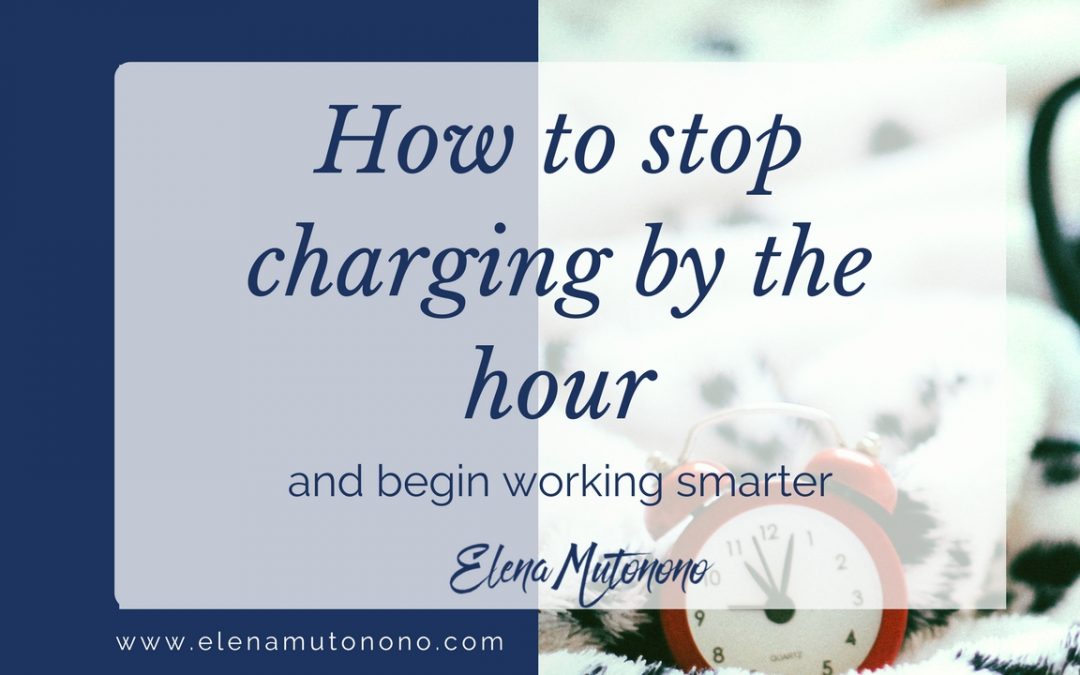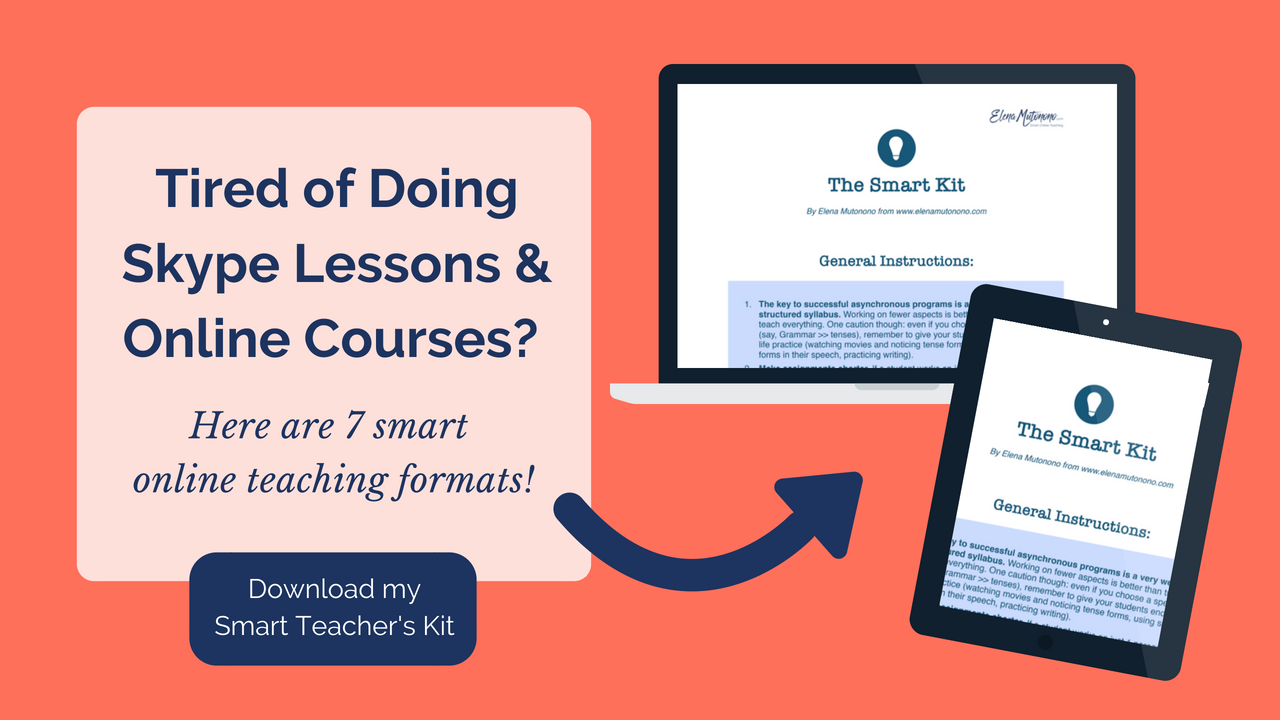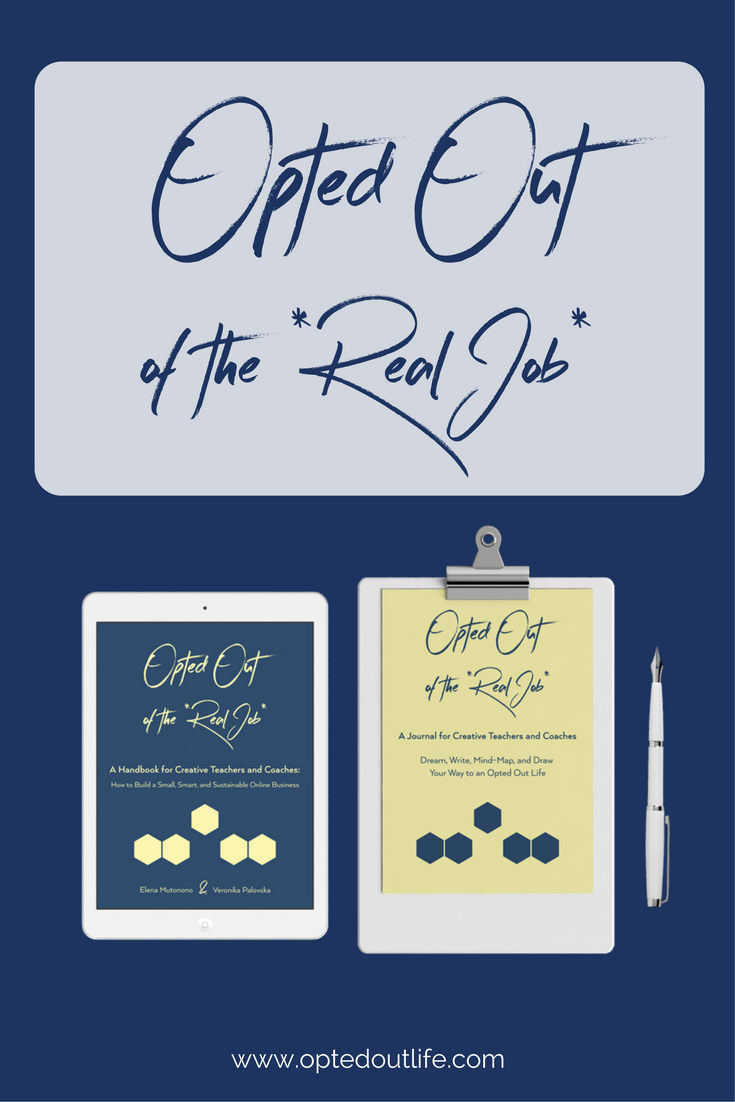I started my business by charging $15 per hour for language lessons. It was a welcome upgrade from the stressful College teaching job I’d had prior. Within 6 months I discovered that exchanging my time for money impacted my physical well-being and my productivity. It drained my passion.
Thus began my journey into working smarter. I’d ask myself how I can give my client better results with less of my time.
I came to the conclusion that to see my client blossom, I’d need to empower them to get where they want to be, not overwhelm them with the information on how to get there.
In this post I’ll outline the main benefits of charging for the package vs. by the hour and lay out the roadmap for those of you who would like to follow suit.
Disclaimer
While charging by the hour is a necessary part of your journey as an online entrepreneur, I see it only as a temporary strategy.
Many people work 60 hours a week and want to cram in more, and if this is the goal for your business, this post will make you uncomfortable.
My brand manifesto is to help you work smarter, and if you wish to work smarter one day you need to start getting yourself ready now.
What are the benefits of charging for a package?
Charging by the hour makes it extremely difficult to plan and budget, you never know exactly what will be added to the bill.
So when I began charging for a package I discovered incredible benefits, both for myself and my client:
For myself:
- Makes it easy to budget (I never ask myself how many weeks there are in a month and I never have to count how many sessions I will have with the person).
- Reduces my workload (allows me to work smarter by helping me focus on the client’s results, not the time we spend together online).
- Improves my productivity (I can choose when I do client work. This is totally different when you work by the hour and have to stop your flow to do a session).
For my client:
- Turns the hours into an experience. When they pay for the result, they anticipate taking this journey and arriving there, as opposed to finding the time for sessions.
- Takes guesswork out of their routine. They can write to me, get feedback, get more information and motivation as a part of their package.
- Motivates them to work harder by applying what they’ve learned. After all, it’s their work that will facilitate learning.
How do you transition into charging by the package, not by the hour?
You can’t just tell your clients one day, “OK, you paid me $$ per hour, now you’ll be paying for a package.” Unless you want to lose or confuse them I don’t recommend anything radical.
So there’re certain steps towards smarter online work, and I will list 3 to help you understand the process. Please don’t skip the steps or try to complete step 1 in 1 day.
Step 1: Mindset shift.
I talk about mindset all the time. That was one revealing truth that came out in the process of writing my books and reflecting on my experience. I realized it had taken me that long because I focused on the how-tos, rather than on the mindset shift.
Also, because we’re bombarded by the “charge-so-much-by-the-hour” messages from everywhere it’s hard to be courageous and set up your boundaries.
We’re afraid people will criticise us. And you can’t make bold changes when you’re afraid. Hence the mindset shift. Let’s dig deeper into what this mindset shift really means.
#Entrepreneurs: Work smarter. Stop charging by the hour. Here's a guide to help you.Click To Tweet
#1: Your clients will get the best results when they do most of the work, not you.
At one point in my online business I realized that 1:1 sessions were a crutch for one of my clients. It’s as though he said, “well, at least I showed up, I’m learning something.” So I restructured the program to help him achieve his results.
In 3 months he got 8 out of 9 on his IELTS speaking test (that’s after years of not being able to go past 6.5). Your clients get results when they put in the work. It’s not our show.
#2: You are a facilitator, a guide, a coach.
It’s hard to take ourselves out of the picture. It seems impossible to provide a 3-page program instead of a 300-page manual. It’s a challenge to ask a question, not give the answer.
A coaching job is the job of knowing how to make ourselves small until we’re no longer needed. We all know it, but it’s tough to implement. Mind you, by “asking a question” instead of providing pages of extensive answers I’m not downplaying our roles.
Sometimes asking a question is a lot harder. Making things small seems impossible.
A #coaching job is the job of knowing how to make ourselves small until we’re no longer needed.Click To Tweet
#3: Your best work is empowering your client.
You want your client to achieve results, but you also need to empower her to want to go beyond these results.
When I took Veronika Palovska’s coaching program, I didn’t just “cover the material” that made me feel accomplished. I sweated and struggled to go through the questions and prompts so my website copy represents my beliefs.
But once I was done I felt empowered to write like never before, and my writing alone began bringing me clients.
I guess I could have taken a regular class where I would listen to a person “tell me” about writing powerfully for your blog/website, but it wasn’t until I did it that I felt the difference.
Her packaging prompted me to do, not just observe.
***
Want to learn how to increase your prices in a smart way? Join my mini-course!
***
Step 2: Package your service.
When the mindset shift happens, you will realize that a package is more than a number of lessons paid by the hour. In the second short tutorial of the Make your First $1k challenge in the Smart Teacher’s Library I go through the packaging process and then make you package your own services using the worksheet.
Here’s the summary:
- Package more than just 1:1 sessions.
- Set a desired result/goal
- Set a timeline (how long it will take, make it no longer than 6 weeks)
- Think through benefits (don’t confuse them with features)
- Create a description (please be sure to weed out cliches so it’s punchy).
Packaging your service to help your client get a specific result will empower your client to want the result more than showing up for the 1:1 sessions. It’s hard work, but it definitely pays off.
Step 3: Make that offer.
You may think your offer isn’t polished or exclusive enough. You’re embarrassed that it’s not perfect. Perhaps you want to take 1 more month to “make sure” things work.
The “making sure” part for me means that I’m numbing my fear of failure. I don’t want to offer and get a “no,” so I’ll just spend a few months in the “making sure” zone.
Making an offer is an act of courage. You don’t have to be “ready.” You have to be bold.
Making an offer is an act of courage. You don’t have to be “ready.” You have to be bold.Click To Tweet
When you make your offer for the first time, especially to people who are used to paying by the hour, you’re a *bit* anxious. But the only way to find out what they think of it is to ask.
Here’s what you want to include into your email offer the first time:
-
- Talk about this program as a pilot project for the select few.
- Explain why your client will benefit from participating (list benefits, not features).
- Give an assurance that if they want to go back to by-the-hour system, they can do it.
- List the price and position it as a bargain (see these pricing strategies).
- Let people know that they’re free to say no, and it’s OK (it really is OK).
- Give people the deadline to respond to your email.
- Follow up.
Creating packages is a smarter way to run your business. You will quickly discover that once your client sees results, they will want to continue with the same package. If you’re not sure how to provide results, you may work through your packages in more detail (This mini-course can help!).
Packaging your services is nothing but empowering your client to want the result. Talking about a result, sharing information, giving useful videos or links will not give your client the result until they want it. Your only job is to empower the client so they want the results greatly.
You don’t need a huge course with large tutorials to do it. Sometimes a series of life-changing questions on a google doc is what it takes.
Your to-do list for today:
Take a pen and a notebook and write down the answers to these questions (and craft your plan):
- List 5 specific results that your clients want when they work from you?
- What needs to happen for them to achieve those results (specific conditions on their part, like finding time, being consistent, working on specific tasks daily/X times a week, etc.)?
- How can you empower your client to achieve those results (help them with their mindset blocks, give them tips on how to free their time, provide progress tracking sheets, create activities etc.)? Draft your package contents.
- How many clients can you realistically work with to assure they get these results in 4 weeks? Add 1-2 more to that number.
- What would be your “happy” amount to receive at the end of the month for the work with these clients? Divide that number by the number of clients. That’s your average charge for a package. More pricing tips here.
- Multiply the number of your desired clients by 3 and select that number of prospects from your list, and send them your offer (you have to have more prospects than the desired number of clients).
- Join my mini-course on how to increase your prices to learn more about pricing and how to scale your current offers.




 Welcome to my nook where *Big Magic* happens. My name is Elena Mutonono, I help small business owners package their services as digital products and sell them online. I want you to work smarter, not harder. Increase your impact beyond your current face-to-face clients. Grow your business as you reach more people all over the world.
Welcome to my nook where *Big Magic* happens. My name is Elena Mutonono, I help small business owners package their services as digital products and sell them online. I want you to work smarter, not harder. Increase your impact beyond your current face-to-face clients. Grow your business as you reach more people all over the world.








Not long after I read this I went back to Veronika’s worksheets as I had a sales page to write. I feel that I’m still struggling to figure out what it is that me and my ideal client believe. A word came up that I’d written last time which was ‘outsider’ and it started to make more and more sense as I read it.
I also read back what I wrote in response to “why do you do what you do” and I realised I’d written that I’d left my old job because I didn’t believe in what I was selling/doing. I’d used the language of ‘why’ to articulate what I wasn’t doing any more, which is one of the core principles Veronika uses in her work.
So, yes I totally agree that just a few questions on a Google doc is what it takes for a seismic shift or a breakthrough to occur. The fact that I turn to the same worksheets from Veronika for every sales page I write shows how packaging your services so that your clients do the work empowers them and sets them off on a journey where they don’t need you any more. It makes me think of that proverb “when the student is ready the teacher will appear. When the student is ready, the teacher will disappear”.
Yes! I go back to the same worksheets and think through those questions again and again. I think the first skill teachers should learn is how to ask a question to teach, or rather to transform.
Thanks, Elena. Good stuff. Really makes sense. I am researching things now to build a knowledge base and skill level in developing an online teaching venue. You are a resource I will be proud to come back to.
Hey Glenn!
Thanks for stopping by and good luck with your research!